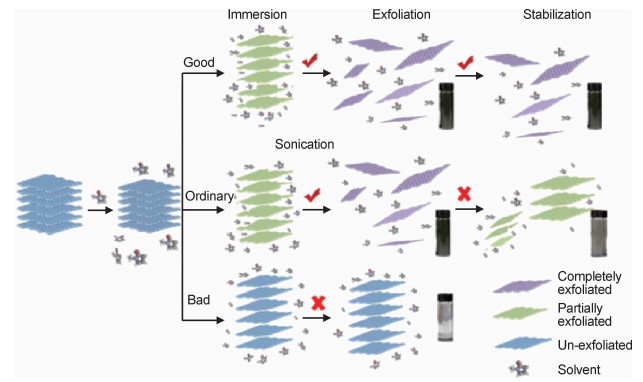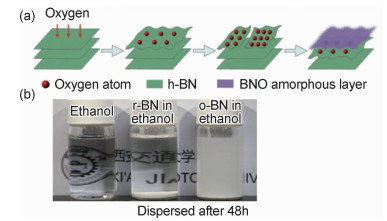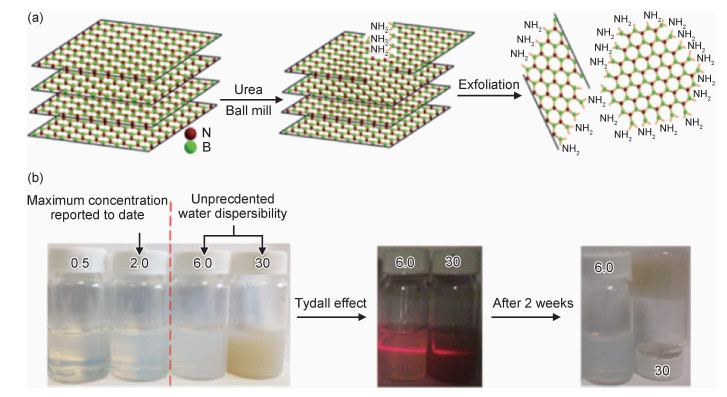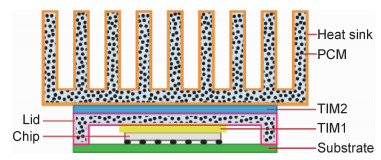文章信息
- 孙川, 邱学青, 覃发梅, 丁子先, 方志强
- SUN Chuan, QIU Xue-qing, QIN Fa-mei, DING Zi-xian, FANG Zhi-qiang
- 六方氮化硼的液相剥离及其在电子器件热管理应用的研究进展
- Research progress in liquid phase exfoliation of boron nitride and their applications in thermal management of electronic devices
- 材料工程, 2019, 47(12): 21-32
- Journal of Materials Engineering, 2019, 47(12): 21-32.
- http://dx.doi.org/10.11868/j.issn.1001-4381.2018.001461
-
文章历史
- 收稿日期: 2018-12-20
- 修订日期: 2019-04-28
2. 华南理工大学 制浆造纸工程国家重点实验室, 广州 510641
2. Key Laboratory of Pulp and Paper Engineering, South China University of Technology, Guangzhou 510641, China
随着电脑、手机、电视机等电子器件的集成程度和功率不断提高,器件内部产生大量难以耗散的热量,进而引起器件工作温度的急剧上升[1]。过高的工作温度对电子器件的性能和寿命产生较大的影响。据统计,55%的电子设备失效是由温度超过规定值引起的[2]。发展导热材料是解决电子器件散热问题的有效途径之一。
电子器件的高性能化和多功能化发展及其应用环境的复杂性对导热材料提出了新的要求。传统的导热材料金属、金属氧化物及其他无机材料具有很好的导热性,但存在稳定性差或电绝缘性较低等问题,限制了其在电子器件热管理领域的应用。例如,在电器设备中使用的高散热界面材料及电子信息领域中使用的功率管、集成块,不仅要求材料具有较好的导热性能,还需要良好耐高温性以及电绝缘性。
BNNS是一种结构与石墨烯相近的新型二维无机纳米材料,但与石墨烯不同的是,BNNS不仅拥有高的导热系数,而且具有良好的绝缘性以及化学稳定性,在电子器件热管理领域具有巨大的发展潜力[3]。然而,如何高效地制备高质量BNNS是实现其商业化应用的一个重要挑战。在现有众多制备方法中,液相剥离二维材料的方法凭借成本低、操作简单、片层质量较高以及环境友好等优点逐渐成为制备二维材料的主要方法[4]。本文综述了液相剥离制备BNNS的3种方法,深入探讨了3种方法的剥离机理以及存在的不足;最后,论述了BNNS在热管理领域应用的研究进展及展望。
1 六方氮化硼的结构和性质氮化硼(BN)最早发现于100多年前,但当时并未获得足够的关注。随着二维材料在化学、物理及材料科学等领域的兴起,氮化硼开始引起科学家的关注。氮化硼根据空间结构可分为3种:立方体氮化硼(c-BN)、六方形氮化硼(h-BN)以及无定形氮化硼(a-BN)[5]。其中,h-BN的结构与石墨烯相似,呈现出优异的导热性、绝缘性、化学稳定性、耐高温性,在能源储存、半导体电子器件、催化剂载体、热管理等多个领域具有光明的应用前景[4]。
h-BN是松散、质地柔软且有光滑感的白色粉末(图 1(a)),性质与石墨类似,故有“白色石墨”之称。其结构相当于石墨烯六边蜂窝形碳单元结构上相邻的两个碳原子,依次被硼原子和氮原子取代,是一种典型的六元环共轭结构, 如图 1(b)所示[6]。石墨层与层之间是一种ABA结构(上下层原子非对齐结构),层间的相互作用力只有范德华力;而h-BN层与层之间是一种AAA结构(上下层原子对齐结构),层间距为0.333nm,层间的相互作用力除了范德华作用力,还存在离子键属性的lip-lip作用力[3]。
h-BN呈现出许多优异的性能,如表 1所示。例如,h-BN微弱的层间作用力,导致层与层之间易滑动,从而呈现出良好的减摩擦性能。由于声子在垂直于热传导的方向几乎没受到边界的散射和束缚,h-BN面内呈现出高热导率。面内结合力强的硼-氮共价键赋予h-BN高的热稳定性、化学稳定性和耐腐蚀性[5],可耐2000℃的高温(惰性气体中),热膨胀系数仅次于石英[7]。h-BN的能带间隙宽度为5~6eV,呈现出优异的绝缘性[8]。
| Performance | Detail | Application |
| Lubricating property | Good friction-reducing performance | Solid lubricant |
| Good heat resistance, resistance to 2000℃ (inert gas), sublimation temperature 3000℃ | ||
| Thermal property | High thermal conductivity | Thermal management |
| Low thermal expansion coefficient | ||
| Electrical property | Good electrical insulation, dielectric constant:5-6eV | Insulating materials |
| Chemical property | Stable in most oxidants, inorganic acids/bases | Anticorrosive materials |
BNNS是厚度仅为几纳米或者几十纳米,具有纳米尺寸效应的h-BN纳米片。与块状h-BN相比,BNNS热传导性能、电绝缘性能、光学性能、力学性能等都显著提升:(1)比表面积大。高的比表面积使BNNS在催化方面和储存能量方面有较好的应用[9]。(2)BNNS的热导率远远高于块体h-BN。BNNS(002)晶面上的热导率高达2000W/(m·K)[7],而块体氮化硼的热导率仅为600W/(m·K)[5]。(3)显著的增强作用。与其他聚合物进行复合,能显著提高聚合物的强度,且复合材料的强度和刚度随BNNS厚度的减小而增强。
3 BNNS的制备方法BNNS的制备方法分为两大类:“自下而上”法和“自上而下”法[10]。“自下而上”法是通过原子和分子直接化学合成BNNS。例如化学气相沉积法(CVD)[6, 11-12]、固相合成法(SPS)、电化学沉积法(ED)。该类方法可实现二维材料纳米片按一定比例合成,对晶粒大小、层数、结晶度和形貌等参数进行可控调节,从而制备出片层均匀、纯度高、质量好的BNNS[6, 11-12]。但是这类方法存在制备时间长、能耗大、产量低和制备工艺条件苛刻等缺陷。
“自上而下”法是通过破坏层状结构的h-BN的层间结合力制备得到BNNS。其中最常见的“自上而下”法是机械剥离法,包括胶带法[13]、球磨法[14]、流体剥离法[15-16]等。相比于“自下而上”法,机械剥离法的优势在于操作简单、成本低、效率高。但剥离过程中巨大的能量会严重破坏h-BN的片层结构,导致其导热性能下降。2008年,Coleman等[17]首次提出采用液相剥离法剥离二维材料,为大规模生产高质量的BNNS指明了方向。本文将重点介绍BNNS的液相剥离方法。
3.1 液相剥离法液相剥离法是在溶剂中利用超声或者其他能量来破坏二维材料层间作用力,获得二维材料纳米片分散液,具有能耗低、环境友好、纳米片质量较高等优点。根据液相剥离法的原理可分为单步溶剂超声剥离法、非共价键改性液相剥离法和共价键改性液相剥离法。
3.1.1 单步溶剂超声剥离法单步溶剂超声剥离法是在超声波的辅助下,利用有机溶剂分子与氮化硼表面间的强相互作用,破坏h-BN层与层之间的作用力制备出BNNS分散液。如图 2所示,当选择剥离的良溶剂时,在外界能量的作用下能有效地将块体h-BN剥离成纳米片,并维持其稳定分散BNNS的状态。热动力学分析表明:溶剂的表面张力是影响超声剥离效率及分散液稳定性的重要因素之一;溶剂与二维材料的表面能越接近,溶剂分子与二维材料相互作用越强,剥离分散的效果越好[18-19]。
二甲基甲酰胺(DMF)[20]、二甲基亚砜(DMSO)、N-甲基吡咯烷酮(NMP)[21]、1,2-二氯乙烷[22]等溶剂与h-BN表面能相近,已被证实能在超声条件下成功制备出厚度小于10nm的BNNS。溶剂的Hansen溶解度参数(HSP)是影响二维材料剥离分散效果的重要相关指标[18]。溶质在溶剂中的相互作用强度可直接通过对比溶剂系统和溶质的色散参数( &D)、极性参数( &P)、氢键参数( &H)的相互作用来解释。溶剂的选择可对比溶剂与溶质HSP的差值Ra,Ra=[4( &D, 1- &D, 2)2+( &P, 1- &P, 2)2+( &H, 1- &H, 2)2]0.5[19](式中的1,2分别代表溶剂和溶质)。通过对比Ra参数,可知当二者的 &D、&P和 &H接近时,Ra值越小,溶剂对二维材料的剥离效果最佳。异丙醇(IPA)的表面张力(约23mN/m)与h-BN(40mN/m)相差较大,而通过对比发现,溶剂中BNNS的HSP:&D, BN (17~19MPa1/2),&P, BN (4~10MPa1/2)和 &H, BN(4~10MPa1/2)和IPA的HSP:&D, BN(15.83MPa1/2),&P, BN (6.11MPa1/2)和 &H, BN(16.44MPa1/2)[18-19]相近,在单步溶剂超声制备BNNS的过程中,IPA同样是剥离h-BN的良溶剂[21]。
单一溶剂的表面能与HSP通常不能同时与h-BN接近,因此,通过两种或多种溶剂的混合来调控溶剂的表面张力和HSP是提高剥离效率的有效措施之一[18]。例如,IAP/H2O(质量比为1:1)和NMP/H2O(质量比为3:7)混合溶剂,混合后溶剂的表面张力和HSP与h-BN接近[18]。IAP/H2O混合溶剂用于h-BN的分散和剥离,能够有效提高h-BN的剥离效率(BNNS得率达25%)和分散稳定性[18]。混合溶剂除了能够有效调节溶剂的剥离参数之外,同时也能形成一些其他稳定作用。NMP/H2O混合溶剂调节溶剂剥离能的同时,NMP分子还能与H2O分子生成(NMP·2H2O)m的聚合物,在纳米片片层之间起到一定的位阻作用,使BNNS分散液更加稳定[19]。Cao等[23]则采用氨水/异丙醇双溶剂方法剥离h-BN,使BNNS的得率达到20%。异丙醇由于与h-BN具有相匹配的表面能,起到分散作用;而氨水中的氨分子作为电子供应体,易于攻击氮化硼的B原子,形成路易斯酸碱交互作用。
3.1.2 液相表面改性采用水等绿色溶剂进行二维材料的剥离和分散是目前的研究热点[24]。但水的表面能与二维材料的表面能相差较大,属于不良溶剂。为增强水分子与h-BN的相互作用,通过加热、超声、化学处理、添加修饰分子等方式对h-BN进行表面改性,从而提高BNNS的剥离效率和分散稳定性。
3.1.2.1 非共价键改性液相剥离法非共价键改性液相剥离法是指在液相剥离的过程中加入稳定剂,使其通过疏水作用、π-π作用、静电作用、电荷转移等非共价键作用吸附在h-BN的表面, 提供空间位阻、静电排斥作用和改善疏水作用,从而实现h-BN的剥离与稳定分散[25]。常用于非共价键改性的稳定剂主要有4类:聚合物、表面活性剂、无机盐和质子酸。聚合物(聚乙烯吡咯烷酮(PVP)、十二烷基聚氧乙烯(4)醚、聚氧化乙烯、聚乙二醇辛基苯基醚等)和表面活性剂(吐温类、十二烷基苯磺酸钠、十六烷基三甲基溴化铵(CTAB)、聚醚F-68等)这两类稳定剂主要依靠疏水-疏水作用和静电作用,吸附在二维材料表面和层间,改善表面能,增强溶剂与二维材料的相互作用。其中,分子结构中带N原子的亲电稳定剂能够与h-BN形成较强的路易斯酸碱作用,能够较大地提升剥离效率和分散稳定时间。Chen等[26]利用三乙醇胺与h-BN的路易斯酸碱作用高效制备出稳定的BNNS分散液。仅在1000r/min的机械搅拌下,就能将微米级h-BN剥离成厚度为1~2nm的纳米片,且分散液可以稳定9个月以上。
另外,一些无机盐离子由于其带电性及体积小,容易插层在二维材料中,提升剥离效率。Wang等[27]通过锂离子插层辅助的水热剥离法高得率制备稳定的BNNS分散液。在高压水热釜的临界反应条件下,通过选择与h-BN剥离能相匹配的极性溶剂和高速搅拌,可以将微米级块体h-BN剥离成几个原子层厚度BNNS,分散液浓度达到4.13mg/mL,产率高达55%。质子酸(甲基磺酸)来修饰制备BNNS是Yin课题组在2011年首次提出来的[8]。甲基磺酸(MSA)作为质子酸影响BNNS的表面电荷分布,形成了带离子化的带正电部分,电荷在片层之间引起排斥力,从而促进剥离和分散过程。通过该法制得BNNS厚度在3nm以下,分散液的浓度可达0.03mg/mL。尽管通过聚合物、表面活性剂和质子酸等非共价键修饰剂能有效剥离和分散BNNS,但在实际应用过程中仍存在修饰剂成本高,相容性较差,修饰后难以去除等缺点。
为了解决上述问题,生物大分子成为提高剥离分散质量的新选择。一些绿色天然高分子因其优异的相容性和低成本(如多糖和植物提取物[28-32]、蛋白质和肽[33-35]、核苷酸RNA和DNA[36-40]、胆汁盐[41-43]),已经成功应用于纳米材料的剥离分散。纳米纤维素因其吡喃葡萄糖环上的亲水性—OH和疏水性C—H展现出两亲特性,被广泛用于分散碳纳米管[32]、石墨烯[30]、六方氮化硼[31]、氮化硼纳米管[28]、硫化钼[31]等无机材料。Bourlinos等[33]将纳米纤维素用于剥离和分散石墨(图 3(a)),制备出分散性好、稳定性高的多层石墨烯薄片的水性分散液,并通过真空抽滤自组装的方法制备出性能优异的纳米复合薄膜。当纳米纤维素用于分散碳纳米材料时,其本身所带的高电荷容易使碳纳米材料极化程度变高,进而导致二者的结合能变大,电荷越高,其在分散体系中提供的静电斥力越大[32]。此外,纳米纤维素的空间位阻作用也为纳米材料的均匀分散起到重要作用[28, 30-32, 44]。肝素是一种由葡萄糖胺、L-艾杜糖醛苷、N-乙酰葡萄糖胺和D-葡萄糖醛酸交替组成的黏多糖硫酸脂的生物大分子。它由相对疏水的纤维素骨架组成,并被稠密的亲水羧酸盐和磺酸盐基团所包围(图 3(b))。由于疏水作用,石墨烯表面与肝素的相互作用结合。此外,肝素的带电表面之间的斥力使石墨烯稳定地分散在水性体系中[45]。维生素(B2黄素单核苷的钠盐)(RNA)由于异咯嗪部分的强吸附作用,而成为一种非常有效的石墨烯分散剂,在水性体系中制备出高浓度无缺陷的石墨烯片(图 3(c)),其最高浓度可达50mg/mL[36]。
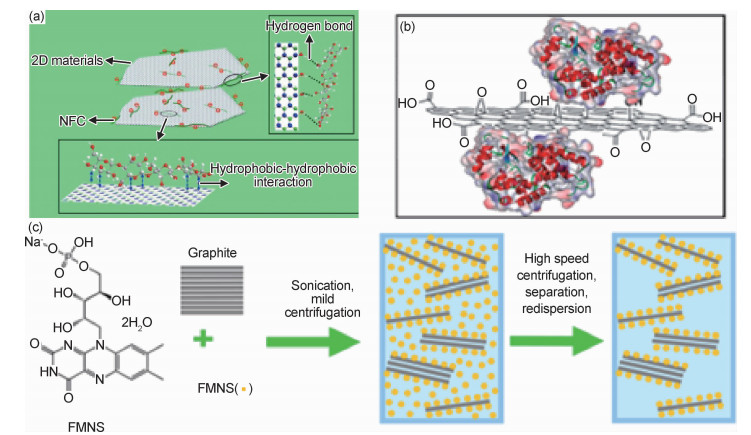
|
图 3 生物大分子辅助剥离分散二维材料 (a)纳米纤维素剥离分散二维材料[33];(b)肝素与还原氧化石墨烯相互作用[45];(c)黄素单核苷钠盐剥离和分散石墨示意图[36] Fig. 3 Biological macromolecules assisted in exfoliating and dispersing two-dimensional materials (a)nano-cellulose exfoliating and dispersing two-dimensional materials[33]; (b)interaction between Heparin and RGO[45]; (c)diagram of exfoliating and dispersing graphite of FMNS[36] |
离子液体作为一类新型的绿色溶剂,为创建全新的剥离工艺提供了很多机遇。离子液体具有不挥发、热稳定性和化学稳定性高、溶解性好、性能可调、易分离、易回收、可循环使用等特点[46]。离子液体用于剥离二维材料,不仅能提高剥离效率,还有助于提升二维材料的性能,是解决表面活性剂及聚合物等修饰不足的有效途径之一。Wu等[47]合成了一种热敏聚合型离子液体(TRPIL)用于h-BN的剥离与分散(图 4(a))。BNNS与TRPIL的阳离子媒介发生相互作用(图 4(b)),有效地促进了剥离的同时,还赋予BNNS一定的功能。由于TRPIL的热交换相变行为,被剥落的纳米片在悬浮液中的分散形态可以通过温度进行可逆的调整。但是,目前离子液体用于h-BN的剥离存在成本过高的问题。
共价键改性通过在硼原子表面接枝—OH,—NH2,—X等功能基团[5]来调节h-BN的亲疏水性,削弱BNNS之间的相互作用力,实现BNNS在水体系中的剥离和稳定分散。目前,h-BN共价键改性的方法主要有羟基化改性和氨基化改性。
羟基化改性是目前常用于h-BN共价键改性的一类方法,主要包括4种:(1)直接超声法。将h-BN在水中进行超声使其发生破碎,进而发生水解引入羟基。其分散液浓度可以达到0.05~0.1mg/mL,但由于改性程度极低,存在剥离效率不高的问题[48]。(2)氧化法。Han等[49]证明在600℃的空气中,保证时间足够长(144h)的氧化,同样能够在h-BN的片层中引入—OH, 并可以得到高含氧量的OH-BNNS。在低温氧化的过程中,氧原子不断被吸收或嵌入缺陷结构中,继而导致晶面沿错位方向分裂成多个部分,而由于形成的裂纹边缘存在高度反应性的悬空键,氧很容易渗透形成大量的B—O键,破坏其六边形结构。而随着氧化时间的延长,这个过程可以重复进行,直到表面h-BN颗粒耗尽,表面最终非晶化(图 5(a))[49]。改性后的h-BN能够在乙醇体系中分散48h后,仍然表现出良好的分散性(图 5(b))。(3)自由基反应法。Sainsbury等[50]提出通过氧自由基共价改性h-BN。其原理是在高温高压下将h-BN与有机过氧化物混合,过氧化物热解生成的氧自由基攻击h-BN晶格中的B原子,进而将羟基引入到h-BN。(4)球磨法。利用化学反应与机械剪切力的作用协同实现h-BN的羟基化改性。Fan[51]将h-BN与次氯酸钠(NaClO)溶液混合球磨,在球墨剪切的同时,利用NaClO与h-BN反应,成功地引入—OH。
氨基化改性是另一种h-BN共价修饰的策略。氨基化改性可以在B-OH的基础上,与氨基试剂反应,间接引入—NH2[5],也可以直接在B原子上反应引入—NH2。尿素与h-BN混合后进行球磨,在剪切力的作用下,h-BN的片层逐渐变薄、变小,并在h-BN破碎的片层周围与尿素反应直接形成—NH2(图 6(a))。从图 6(b)可以看到,经过改性后的h-BN在纯水中的分散浓度和稳定性都有了较大的提升[52]。另外也有Lei等[53]利用NH4Cl作为球磨剂,在高速球磨下对h-BN进行氨基化改性。球磨改性虽然简单有效,但对h-BN片层的损伤较大,导致片层尺寸过小,各方面性能随之下降[54-55]。同样,氮自由基反应[50, 56-57]也能够用于h-BN的—NH2共价键改性。h-BN的氨基化改性,不仅促进了h-BN在溶剂中的剥离,也能促使其稳定分散。
综上所述,共价键改性能够显著增强h-BN与溶剂间的相互作用从而有效地促进h-BN的剥离,但是,由于h-BN的B—N化学键键能高于石墨烯的C—C键,化学稳定性非常高,使得共价键改性仍然面临诸多挑战。
3.2 液相剥离法存在的问题液相剥离法能够有效地破坏h-BN层与层之间的作用力,剥离制备出稳定的BNNS分散液,这对h-BN的应用有着重要的意义。但要进一步提高制备BNNS的效率和质量,仍面临诸多待解决的问题。根据文献的总结和分析,将上述3种方法的优缺点列于表 2。
| Method | Detail | Advantage | Disadvantage |
| One-step solvent exfoliating | IPA, NMP, DMF(appropriate surface energy,HSP) | Low-cost,simple operation,high sheet quality | Organic solvent,low efficency |
| Non-covalent bonding | Polymer, surfactant,inorganic salt,strong acid,biomolecule,ionic liquid | Hydrosolvent,improve performance,high sheet quality | Modified molecules are hard to remove |
| Covalent bonding | —OH, —NH2, —F, etc. functional group | Hydrosolvent, high sheet quality, convenient application | Difficalties in modification Chemical modification involves high temperature, high pressure and strong oxidizing oxidant |
单步溶剂超声剥离法适用于较纯的BNNS的制备。它能够尽可能地保留BNNS的原有性能;但有机溶剂毒性大,剥离周期长是目前此方法存在的主要的问题。寻找绿色的剥离良溶剂以及混合溶剂是解决该问题的发展方向。h-BN的非共价键改性,对h-BN在水体系中的剥离与分散起到积极作用,但不同修饰剂对BNNS的原有性能的影响存在较大差异。Zeng等[58]利用胆酸钠盐表面活性剂对BNNS非共价键修饰进行剥离和分散。胆酸钠盐的加入对BNNS的导热性能有着负面的影响,使得PVA/BNNS复合材料整体的导热性能变差。采用离子液体非共价修饰的方法,不仅能使BNNS表面功能化,还能有效提高其热导效率。h-BN的共价键改性能够极大提升BNNS的液相剥离效率。但由于h-BN极高化学稳定性和热稳定性,改性过程涉及强氧化剂、高温和高压等苛刻条件,因此,h-BN的共价键改性仍然是目前的挑战。
4 BNNS在电子器件热管理领域的应用电子器件正朝着高集成、高功率、小型化的方向发展,这对器件的散热提出了更高的要求。BNNS作为一种新型的绝缘高导热材料,已经在电子器件热管理中有较多的应用。本部分将重点介绍BNNS在高散热复合衬底材料、界面导热材料(电子封装)及相变散热材料(散热器、制冷器)3个方面的应用(图 7)[59]。
具有高导热系数的衬底材料能够有效耗散器件产生的热量,维持器件的正常工作并延长其使用寿命。通过层层有序堆叠得到的BNNS薄膜可以直接应用于电子器件的介电衬底或超薄介电分离层中[60],用于耗散器件工作时产生的热量。研究表明:在同一输入功率的条件下,还原氧化石墨烯(RGO)电子器件直接在玻璃基底上的工作温度(图 8(a))远高于在其在BN薄膜/玻璃基底上(图 8(b))的工作温度;同时,器件的最高工作温度从700℃(玻璃基底)升高到1000℃(BN薄膜/玻璃基底)。良好的导热性能和热稳定性能展现了BNNS在电子器件衬底材料中进行热管理的潜力[61]。
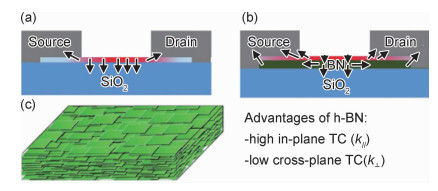
|
图 8 BNNS薄膜衬底的工作原理示意图[61] (a)玻璃衬底的散热示意图;(b)BNNS薄膜-玻璃衬底的散热示意图;(c)BNNS层层堆叠组成的薄膜的示意图 Fig. 8 Schematic demonstrating the working principle of an BNNS thin film as an substrate[61] (a)schematic to heat dissipation of glass substrate; (b)schematic to heat dissipation of glass substrate coating by an h-BN thin film; (c)schematic of thin films comprising layer-by-layer laminated BNNS |
电子器件的柔性化对衬底材料提出了新的要求。衬底不仅需要具有良好的耐热和导热性能,还需具备良好的柔韧性。将BNNS作为导热填料添加到高分子材料中是构建兼具优异导热性能和柔性的衬底材料的有效途径之一[62-66]。Hu等[67]使用纳米纤维素(NFC)分散BNNS并添加到NFC膜中,制备出具有导热功能的NFC-BNNS复合膜(图 9(a))。当BNNS的质量分数达到50%且高度有序的排列时,NFC-BNNS薄膜的热导系数达到145.7W/(m·K)(图 9(b))。该复合膜不仅具有良好的导热性能,同时也具备良好的力学性能,可作为柔性电子器件的衬底材料同时起到机械支撑和散热的作用。
界面导热材料(thermal interface materials,TIMs)是涂敷于散热元器件与发热元器件之间,起到降低二者接触热阻作用的材料(图 10)。在电子热管理中TIMs尤其重要,过大的界面热阻会导致器件温度急剧升高,影响器件的性能、稳定性以及使用寿命。而较理想的TIMs通常需要具备较低的模量系数和较高的导热系数。较低的模量系数赋予材料足够的柔软度,以便在接触压力下变形,填补配合面的间隙。高分子材料被认为是很好的TIMs,但通常具有较低的导热系数,不利于器件的散热管理[59]。
BNNS极高的稳定性和导热系数,意味着仅在低BNNS掺杂量下,高分子材料足以获得所需的导热性能,而不需要牺牲内在的弹性。Lin等[68]在环氧树脂中添加质量分数为5%的BNNS后,其热导系数增强113%。通过红外热成像测量证实,使用BNNS和环氧树脂纳米复合材料作为导热胶黏剂可以有效减少Cu-Si界面间热阻。BNNS纳米片/环氧纳米复合材料不仅导热系数明显提高,而且流动性较好,玻璃化温度高,热膨胀系数低,吸湿性低,在电子封装领域具有良好的应用前景。
近年来,相变材料因其潜热高、安全无毒、成本较低等优点被广泛用于电子器件的散热器中。石蜡的熔点与电子元件的最佳工作范围较为接近,是一种常用的有机相变材料。但石蜡相变材料热导系数低,难以将热量均匀扩散到整个材料,导致散热效率下降。因此,常用的解决方案是在石蜡中加入一些导热填料来提高其导热系数。相比于其他导热填料,BNNS不仅能提升相变材料的导热系数,还能使相变材料保持低的热膨胀率和绝缘性以及较高的化学稳定性。这种性能优异的纳米复合相变材料可以广泛用于各种热源端的电子元器件的散热片和散热器中。
综上所述,BNNS具有优异的导热和绝缘性能,在电子器件的热管理领域具有光明的应用前景。但是为了充分发挥BNNS的优异性能,应当从以下两个方面思考:高质量的BNNS的制备和BNNS组装成宏观结构的设计。在导热复合材料中,具有较高横纵比的BNNS纳米材料能够赋予复合材料更好的导热性能及力学性能。因此,BNNS的高质量制备是首要考虑的问题。从表 3可知,目前,液相剥离法是制备质量较好的BNNS的主要方法之一,也是最有前景的剥离制备方法。在此基础上,可从BNNS的应用宏观结构设计,实现高导热性的复合材料的制备。根据电子器件热管理环境,设计组装成不同的三维宏观结构(根据散热要求,薄膜、泡沫或具有确定结构的三维整体),充分发挥其优异性能。
| Raw material | Mass fraction of loading/% | Thermal conductivity of composite material K/(W·m-1·K-1) | Method(BNNS) | Electronic device thermal management | Reference |
| NFC | 2.5 | 0.76 | One-solvent ultrasound(IPA) | Dielectric substrate | [69] |
| PMMA | 30 | 1.5 | Heat treatment (1300℃) | [70] | |
| NFC | 50 | 147.5 | One-solvent ultrasound(IPA) | [67] | |
| - | 100 | - | One-solvent ultrasound(IPA) | [61] | |
| PDDA | 30 | 200 | Covalent functionalization | TIMs(high temperature and corrosion resistant coating, electronic packaging) | [71] |
| Silicon-based resin | - | - | - | [72] | |
| Epoxy | 5 | 0.35 | Ultrasound(NMP) | [68] | |
| Epoxy | 10 | 1.58 | Noncovalent functionalization | [73] | |
| Paraffin wax | 10 | 0.55 | Business purchase | PCMs(electronic heat dissipation) | [74] |
| Wax | - | 3.47 | Noncovalent functionalization | [75] |
BNNS凭借其优异的导热性、绝缘性、化学稳定性以及耐高温性,在电子器件热管理领域展现了广阔的应用前景。然而,如何高效、绿色、低成本地获得高质量(片层大,厚度小)的BNNS是目前该领域存在的关键问题之一。液相剥离法具有操作简单、成本低的特点,制备的BNNS质量高且方便后续应用,广泛应用于h-BN的剥离和分散。但是,液相剥离法还存在以下问题:(1)有机溶剂对环境存在一定负面影响,且增加了生产成本;(2)效率低,剥离周期较长,这也是液相剥离法一直以来面临的最大问题;(3)共价改性困难。随着剥离分散机理的深入研究,溶剂和BNNS的相互作用机制的研究和完善,液相剥离法将能满足更高质量、更高效率的BNNS的制备,使其更广泛地在电子器件的热管理领域发挥作用。
| [1] |
李响. 导热材料对某相变储热器性能的影响[J]. 金属功能材料, 2018(2): 53-56. LI X. Effects of thermal conductive material on the performance of a phase change heat storage device[J]. Metallic Functitonal Materials, 2018(2): 53-56. |
| [2] |
BELHARDJ S, MIMOUNI S, SAIDANE A, et al. Using microchannels to cool microprocessors:a transmission-line-matrix study[J]. Microelectronics Journal, 2003, 34(4): 247-253. DOI:10.1016/S0026-2692(03)00004-1 |
| [3] |
LUO W, WANG Y, HITZ E, et al. Solution processed boron nitride nanosheets:synthesis, assemblies and emerging applications[J]. Advanced Functional Materials, 2017, 27(31): 1701450. DOI:10.1002/adfm.201701450 |
| [4] |
WAN J, LACEY S D, DAI J, et al. Tuning two-dimensional nanomaterials by intercalation:materials, properties and applications[J]. Chemical Society Reviews, 2016, 45(24): 6742-6765. DOI:10.1039/C5CS00758E |
| [5] |
ZHENG Z, COX M, LI B. Surface modification of hexagonal boron nitride nanomaterials:a review[J]. Journal of Materials Science, 2018, 53(1): 66-99. |
| [6] |
SONG L, CI L, LU H, et al. Large scale growth and characterization of atomic hexagonal boron nitride layers[J]. Nano Letters, 2010, 10(8): 3209-3215. DOI:10.1021/nl1022139 |
| [7] |
张平奇.氮化硼纳米片的规模化制备工艺探索[D].大连: 大连理工大学, 2016. ZHANG P Q. Investigation of the scale-up preparation process of hexagonal boron nitride nanosheets[D]. Dalian: Dalian University of Technology, 2016. http://cdmd.cnki.com.cn/Article/CDMD-10141-1016217898.htm |
| [8] |
WANG Y, SHI Z, YIN J. Boron nitride nanosheets:large-scale exfoliation in methanesulfonic acid and their composites with polybenzimidazole[J]. Journal of Materials Chemistry, 2011, 21(30): 11371-11377. DOI:10.1039/c1jm10342c |
| [9] |
WANG Y, ZHAO L, SHI L, et al. Methane activation over a boron nitride catalyst driven by in situ formed molecular water[J]. Catalysis Science & Technology, 2018, 8(8): 2051-2055. |
| [10] |
DONG R, ZHANG T, FENG X. Interface-assisted synthesis of 2D materials:trend and challenges[J]. Chemical Reviews, 2018, 118(13): 6189-6253. DOI:10.1021/acs.chemrev.8b00056 |
| [11] |
WANG L, WU B, CHEN J, et al. Monolayer hexagonal boron nitride films with large domain size and clean interface for enhancing the mobility of graphene-based field-effect transistors[J]. Advanced Materials, 2014, 26(10): 1559-1564. DOI:10.1002/adma.201304937 |
| [12] |
KIM K K, HSU A, JIA X, et al. Synthesis of monolayer hexagonal boron nitride on Cu foil using chemical vapor deposition[J]. Nano Letters, 2012, 12(1): 161-166. DOI:10.1021/nl203249a |
| [13] |
PACILE D, MEYER J C, GIRIT C O, et al. The two-dimensional phase of boron nitride:few-atomic-layer sheets and suspended membranes[J]. Applied Physics Letters, 2008, 92(13): 133107. DOI:10.1063/1.2903702 |
| [14] |
QIU S, HOU Y, XING W, et al. Self-assembled supermolecular aggregate supported on boron nitride nanoplatelets for flame retardant and friction application[J]. Chemical Engineering Journal, 2018, 349(1): 223-234. |
| [15] |
CHEN X, DOBSON J F, RASTON C L. Vortex fluidic exfoliation of graphite and boron nitride[J]. Chemical Communications, 2012, 48(31): 3703-3705. DOI:10.1039/c2cc17611d |
| [16] |
刘闯, 张力, 李平, 等. 氮化硼二维纳米材料剥离制备技术研究进展[J]. 材料工程, 2016, 44(3): 122-128. LIU C, ZHANG L, LI P, et al. Research progress in boron nitride two-dimensional nanomaterials stripping technology[J]. Journal of Materials Engineering, 2016, 44(3): 122-128. |
| [17] |
HERNANDEZ Y, NICOLOSI V, LOTYA M, et al. High-yield production of graphene by liquid-phase exfoliation of graphite[J]. Nature Nanotechnology, 2008, 3(9): 563-568. |
| [18] |
JIAN F S, YONG M H, JING J W, et al. Liquid phase exfoliation of two-dimensional materials by directly probing and matching surface tension components[J]. Nano Letters, 2015, 15(8): 5449-5454. DOI:10.1021/acs.nanolett.5b01842 |
| [19] |
MANNA K, HUANG H N, LI W T, et al. Toward understanding the efficient exfoliation of two-dimensional layered materials by water-assisted cosolvent liquid phase exfoliation[J]. Chemistry of Materials, 2016, 28(21): 7586-7593. DOI:10.1021/acs.chemmater.6b01203 |
| [20] |
ZHI C, BANDO Y, TANG C, et al. Large-scale fabrication of boron nitride nanosheets and their utilization in polymeric composites with improved thermal and mechanical properties[J]. Advanced Materials, 2010, 21(28): 2889-2893. |
| [21] |
KUANG Z Q, CHEN Y L, LU Y L, et al. Fabrication of highly oriented hexagonal boron nitride nanosheet/elastomer nanocomposites with high thermal conductivity[J]. Small, 2015, 11(14): 1655-1659. |
| [22] |
WARNER J H, RUMMELI M H, ALICJA B, et al. Atomic resolution imaging and topography of boron nitride sheets produced by chemical exfoliation[J]. ACS Nano, 2010, 4(3): 1299-1304. DOI:10.1021/nn901648q |
| [23] |
CAO L, EMAMI S, LAFDI K. Large-scale exfoliation of hexagonal boron nitride nanosheets in liquid phase[J]. Materials Express, 2014, 4(2): 165-171. DOI:10.1166/mex.2014.1155 |
| [24] |
GUARDIA L, PAREDES J, ROZADA R, et al. Production of aqueous dispersions of inorganic graphene analogues by exfoliation and stabilization with non-ionic surfactants[J]. RSC Advances, 2014, 4(27): 14115-14127. DOI:10.1039/C4RA00212A |
| [25] |
SONG X, GAO J, GAO T, et al. Wafer-scale CVD growth of monolayer hexagonal boron nitride with large domain size by Cu foil enclosure approach[J]. Physics, 2015, 8(1): 1-7. |
| [26] |
CHEN H, LIU B, YANG Q, et al. Facile one-step exfoliation of large-size 2D materials via simply shearing in triethanolamine[J]. Materials Letters, 2017, 199: 124-127. DOI:10.1016/j.matlet.2017.04.066 |
| [27] |
WANG N, YANG G, WANG H, et al. A universal method for large-yield and high-concentration exfoliation of two-dimensional hexagonal boron nitride nanosheets[J]. Materials Today, 2018, 27: 33-42. |
| [28] |
ZENG X, SUN J, YAO Y, et al. A combination of boron nitride nanotubes and cellulose nanofibers for the preparation of a nanocomposite with high thermal conductivity[J]. ACS Nano, 2017, 11(5): 5167-5178. DOI:10.1021/acsnano.7b02359 |
| [29] |
PAREDES J I, VILLARRODIL S. Biomolecule-assisted exfoliation and dispersion of graphene and other two-dimensional materials:a review of recent progress and applications[J]. Nanoscale, 2016, 8(34): 15389-15413. DOI:10.1039/C6NR02039A |
| [30] |
SONG N, JIAO J, CUI S, et al. Highly anisotropic thermal conductivity of layer-by-layer assembled nanofibrillated cellulose/graphene nanosheets hybrid films for thermal management[J]. ACS Appl Mater Interfaces, 2017, 9(3): 2924-2932. DOI:10.1021/acsami.6b11979 |
| [31] |
LI Y, ZHU H, SHEN F, et al. Nanocellulose as green dispersant for two-dimensional energy materials[J]. Nano Energy, 2015, 13: 346-354. DOI:10.1016/j.nanoen.2015.02.015 |
| [32] |
HAJIAN A, LINDSTROM S B, PETTERSSON T, et al. Understanding the dispersive action of nanocellulose for carbon nanomaterials[J]. Nano Letters, 2017, 17(3): 1439. DOI:10.1021/acs.nanolett.6b04405 |
| [33] |
BOURLINOS A B, GEORGAKILAS V, ZBORIL R, et al. Aqueous-phase exfoliation of graphite in the presence of polyvinylpyrrolidone for the production of water-soluble graphenes[J]. Solid State Communications, 2009, 149(47): 2172-2176. |
| [34] |
HUANG Y Y, TERENTJEV E M. Dispersion of carbon nanotubes:mixing, sonication, stabilization, and composite properties[J]. Polymers, 2012, 4(1): 275-295. |
| [35] |
GUISEPPI-ELIE A, CHOI S H, GECKELER K E, et al. Ultrasonic processing of single-walled carbon nanotube-glucose oxidase conjugates:interrelation of bioactivity and structure[J]. Nano Biotechnology, 2008, 4(1/4): 9-17. |
| [36] |
AYANVARELA M, PAREDES J I, GUARDIA L, et al. Achieving extremely concentrated aqueous dispersions of graphene flakes and catalytically efficient graphene-metal nanoparticle hybrids with flavin mononucleotide as a high-performance stabilizer[J]. ACS Applied Materials & Interfaces, 2015, 7(19): 10293-10307. |
| [37] |
WALCH N J, NABOK A, DAVIS F, et al. Characterisation of thin films of graphene-surfactant composites produced through a novel semi-automated method[J]. Beilstein J Nanotechnol, 2016, 7(1): 209-219. |
| [38] |
PARVIZ D, DAS S, AHMED H S, et al. Dispersions of non-covalently functionalized graphene with minimal stabilizer[J]. ACS Nano, 2012, 6(10): 8857-8867. DOI:10.1021/nn302784m |
| [39] |
MUNUERA J M, PAREDES J I, VILLAR-RODIL S, et al. High quality, low oxygen content and biocompatible graphene nanosheets obtained by anodic exfoliation of different graphite types[J]. Carbon, 2015, 94(15): 729-739. |
| [40] |
FERNANDEZ-MERINO M J, VILLAR-RODIL S, PAREDES J I, et al. Identifying efficient natural bioreductants for the preparation of graphene and graphene-metal nanoparticle hybrids with enhanced catalytic activity from graphite oxide[J]. Carbon, 2013, 63(2): 30-44. |
| [41] |
SHI M, ZHANG X, WANG X, et al. Direct liquid-phase exfoliation of graphite to produce defect-free graphene[J]. Journal of Nanjing Normal University, 2014, 14(2): 1-7. |
| [42] |
DE S, KING P J, LOTYA M, et al. Flexible, transparent, conducting films of randomly stacked graphene from surfactant-stabilized, oxide-free graphene dispersions[J]. Small, 2010, 6(3): 458-464. DOI:10.1002/smll.200901162 |
| [43] |
SMITH R J, KING P J, LOTYA M, et al. Large-scale exfoliation of inorganic layered compounds in aqueous surfactant solutions[J]. Advanced Materials, 2011, 23(34): 3944-3948. DOI:10.1002/adma.201102584 |
| [44] |
MING S, CHEN G, HE J, et al. Highly transparent and self-extinguishing nanofibrillated cellulose-monolayer clay nanoplatelet hybrid films[J]. ACS Journal of Surfaces & Colloids, 2017, 33(34): 8455. |
| [45] |
MA T Y, TANG Y, DAI S, et al. Proton-functionalized two-dimensional graphitic carbon nitride nanosheet:an excellent metal-/label-free biosensing platform[J]. Small, 2014, 10(12): 2382-2389. DOI:10.1002/smll.201303827 |
| [46] |
BARSKI A, CUDDAPAH S K, ROH T, et al. High-resolution profiling of histone methylations in the human genome[J]. Cell, 2007, 129(4): 823-837. DOI:10.1016/j.cell.2007.05.009 |
| [47] |
WANG X, WU P. Aqueous phase exfoliation of two-dimensional materials assisted by thermo-responsive polymeric ionic liquid and their applications in stimuli-responsive hydrogel and highly thermally conductive film[J]. ACS Applied Materials & Interfaces, 2018, 10(3): 2504-2514. |
| [48] |
LIN Y, WILLIAMS T V, XU T, et al. Aqueous dispersions of few-layered and monolayered hexagonal boron nitride nanosheets from sonication-assisted hydrolysis:critical role of water[J]. Journal of Physical Chemistry C, 2011, 115(6): 2679-2685. DOI:10.1021/jp110985w |
| [49] |
HAN J, LI Y, LI X, et al. Functionalization of hexagonal boron nitride in large scale by a low-temperature oxidation route[J]. Materials Letters, 2016, 175: 244-247. DOI:10.1016/j.matlet.2016.04.008 |
| [50] |
NAZAROV A S, DEMIN V N, GRAYFER E D, et al. Functionalization and dispersion of hexagonal boron nitride (h-BN) nanosheets treated with inorganic reagents[J]. Chem Asian J, 2012, 7(3): 554-560. DOI:10.1002/asia.201100710 |
| [51] |
FAN D, JIN F, LIV J, et al. Hexagonal boron nitride nanosheets exfoliated by sodium hypochlorite ball mill and their potential application in catalysis[J]. Ceramics International, 2016, 42(6): 7155-7163. DOI:10.1016/j.ceramint.2016.01.105 |
| [52] |
LEI W, MOCHALIN V N, LIU D, et al. Boron nitride colloidal solutions, ultralight aerogels and freestanding membranes thro-ugh one-step exfoliation and functionalization[J]. Nature Communications, 2015, 6: 8849. DOI:10.1038/ncomms9849 |
| [53] |
LEI W, DAN L, YING C. Highly crumpled boron nitride nanosheets as adsorbents:scalable solvent-less production[J]. Advanced Materials Interfaces, 2015, 2(3): 1-6. |
| [54] |
LI L H, CHEN Y, BEHAN G, et al. Large-scale mechanical peeling of boron nitride nanosheets by low-energy ball milling[J]. Journal of Materials Chemistry, 2011, 21(32): 11862-11866. DOI:10.1039/c1jm11192b |
| [55] |
LEE D, LEE B, PARK K H, et al. Scalable exfoliation process for highly soluble boron nitride nanoplatelets by hydroxide-assisted ball milling[J]. Nano Letters, 2015, 15(2): 1238-1244. DOI:10.1021/nl504397h |
| [56] |
ZHI C, BANDO Y, TERAO T, et al. Towards thermoconductive, electrically insulating polymeric composites with boron nitride nanotubes as fillers[J]. Advanced Functional Materials, 2010, 19(12): 1857-1862. |
| [57] |
XIE B H, HUANG X, ZHANG G J. High thermal conductive polyvinyl alcohol composites with hexagonal boron nitride microplatelets as fillers[J]. Composites Science & Technology, 2013, 85(9): 98-103. |
| [58] |
ZENG X, YE L, YU S, et al. Artificial nacre-like papers based on noncovalent functionalized boron nitride nanosheets with excellent mechanical and thermally conductive properties[J]. Nanoscale, 2015, 7(15): 6774-6781. DOI:10.1039/C5NR00228A |
| [59] |
AKBULUT M, SCHOLAR E A. Two-dimensional nanomaterials in thermal management applications:further efforts are needed to achieve full potential and wider realization[J]. IEEE Nanotechnology Magazine, 2018, 12(4): 19-27. DOI:10.1109/MNANO.2018.2869232 |
| [60] |
LIN Y, CONNELL J W. Advances in 2D boron nitride nanostructures:nanosheets, nanoribbons, nanomeshes, and hybrids with graphene[J]. Nanoscale, 2012, 4(22): 6908-6939. DOI:10.1039/c2nr32201c |
| [61] |
WANG Y, XU L, YANG Z, et al. High temperature thermal management with boron nitride nanosheets[J]. Nanoscale, 2017, 10(1): 167-173. |
| [62] |
SHIN Y K, LEE W S, YOO M J, et al. Effect of BN filler on thermal properties of HDPE matrix composites[J]. Ceramics International, 2013, 39: 569-573. DOI:10.1016/j.ceramint.2012.10.137 |
| [63] |
GU J, XU S, ZHUANG Q, et al. Hyperbranched polyborosilazane and boron nitride modified cyanate ester composite with low dielectric loss and desirable thermal conductivity[J]. IEEE Transactions on Dielectrics & Electrical Insulation, 2017, 24(2): 784-790. |
| [64] |
GU H, LIU C, ZHU J, et al. Introducing advanced composites and hybrid materials[J]. Advanced Composites & Hybrid Materials, 2018, 1(1): 1-5. |
| [65] |
WANG Y, WU G, KOU K, et al. Mechanical, thermal conductive and dielectrical properties of organic montmorillonite reinforced benzoxazine/cyanate ester copolymer for electronic packaging[J]. Journal of Materials Science Materials in Electronics, 2016, 27(8): 8279-8287. DOI:10.1007/s10854-016-4834-5 |
| [66] |
TRIGUI A, KARKRI M, KRUPA I. Thermal conductivity and latent heat thermal energy storage properties of LDPE/wax as a shape-stabilized composite phase change material[J]. Energy Conversion & Management, 2014, 77(1): 586-596. |
| [67] |
ZHU H, LI Y, FANG Z, et al. Highly thermally conductive papers with percolative layered boron nitride nanosheets[J]. ACS Nano, 2014, 8(4): 3606-3613. DOI:10.1021/nn500134m |
| [68] |
LIN Z, MCNAMARA A, LIU Y, et al. Exfoliated hexagonal boron nitride-based polymer nanocomposite with enhanced thermal conductivity for electronic encapsulation[J]. Composites Science & Technology, 2014, 90(2): 123-128. |
| [69] |
ZHOU L, YANG Z, LUO W, et al. Thermally conductive, electrical insulating, optically transparent bi-layer nanopaper[J]. ACS Applied Materials & Interfaces, 2016, 8(42): 28838-28843. |
| [70] |
WANG X, PAKDEL A, ZHANG J, et al. Large-surface-area BN nanosheets and their utilization in polymeric composites with improved thermal and dielectric properties[J]. Nanoscale Research Letters, 2012, 7(1): 662. DOI:10.1186/1556-276X-7-662 |
| [71] |
WU Y, XUE Y, QIN S, et al. BN nanosheet/polymer films with highly anisotropic thermal conductivity for thermal management application[J]. ACS Applied Materials & Interfaces, 2017, 9(49): 43163-43170. |
| [72] |
BHANG S J, KIM H, KIM K R, et al. Boron nitride-based paint with high heat dissipation performance[J]. Physica Status Solidi(a), 2018, 216(2): 1-6. |
| [73] |
HE Y, WANG Q, LIU W, et al. Functionalization of boron nitride nanoparticles and their utilization in epoxy composites with enhanced thermal conductivity[J]. Physica Status Solidi(a), 2014, 211(3): 677-684. |
| [74] |
FANG X, FAN L, DING Q, et al. Thermal energy storage performance of paraffin-based composite phase change materials filled with hexagonal boron nitride nanosheets[J]. Energy Conversion and Management, 2014, 80: 103-109. DOI:10.1016/j.enconman.2014.01.016 |
| [75] |
YANG Z, ZHOU L, LUO W, et al. Thermally conductive, dielectric PCM-boron nitride nanosheet composites for efficient electronic system thermal management[J]. Nanoscale, 2016, 8(46): 19326-19333. DOI:10.1039/C6NR07357C |
 2019, Vol. 47
2019, Vol. 47




